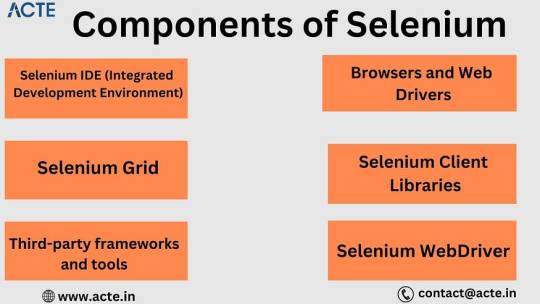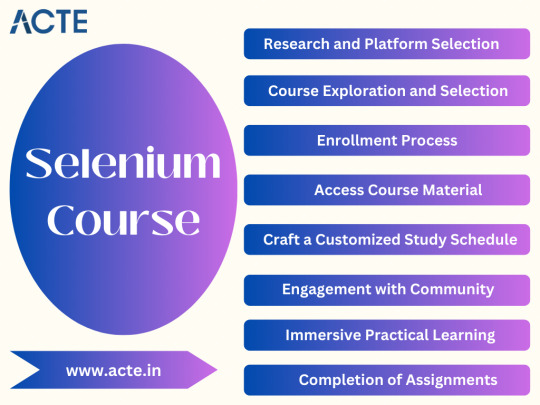#selenium webdriver python
Explore tagged Tumblr posts
Text
Selenium WebDriver Python: Handling Alerts, Pop-ups, and Frames

Selenium WebDriver Python: Handling Alerts, Pop-ups, and Frames
In the world of software testing, Selenium WebDriver stands out as a powerful tool for testing web applications. When combined with Python, it becomes even more robust and versatile. In this article, we will explore how to use Selenium WebDriver with Python to handle alerts, pop-ups, and frames, and how this combination can streamline your python course in bangalore.
Table of Contents
Sr#
Headings
1
Introduction
2
Getting Started with Selenium WebDriver
3
Handling Alerts
4
Handling Pop-ups
5
Handling Frames
6
Best Practices for Selenium WebDriver
7
Conclusion
8
FAQ
Introduction
Selenium WebDriver is a widely used automation tool for testing web applications. It allows testers to simulate user interactions with a web page, such as clicking buttons, filling out forms, and navigating between pages. Python, on the other hand, is a popular Automation with Python programming language known for its simplicity and readability. When used together, Selenium WebDriver with Python becomes a powerful combination for automation testing.
Getting Started with Selenium WebDriver
Before we delve into handling alerts, pop-ups, and frames, let's ensure we have automation python installed in our Python environment. You can install Selenium using pip:
bash
Copy code
pip install selenium
Additionally, you'll need to download the appropriate web driver for the browser you intend to use (e.g., Chrome, Firefox, Safari). These drivers act as intermediaries between Selenium WebDriver and the browser.
Handling Alerts
Alerts are pop-up dialog boxes that appear on a web page to convey important information or to prompt the user for confirmation. python selenium tutorial provides methods to interact with alerts, such as accepting, dismissing, or retrieving text from an alert. Here's an example of how you can handle an alert using Python:
python
Copy code
from selenium import webdriver
driver = webdriver.Chrome()
driver.get("https://www.example.com")
alert = driver.switch_to.alert
print("Alert Text:", alert.text)
# Accept the alert
alert.accept()
Handling Pop-ups
Pop-ups are additional browser windows that open on top of the main browser window. Selenium WebDriver can switch focus to these pop-ups using the switch_to.window() method. Here's an example of how you can handle a pop-up window using Python:
python
Copy code
from selenium import webdriver
driver = webdriver.Chrome()
driver.get("https://www.example.com")
# Click a button that opens a pop-up window
button = driver.find_element_by_id("popup-button")
button.click()
# Switch to the pop-up window
popup_window = driver.window_handles[1]
driver.switch_to.window(popup_window)
# Do something in the pop-up window
print("Title of the Pop-up Window:", driver.title)
# Close the pop-up window
driver.close()
# Switch back to the main window
main_window = driver.window_handles[0]
driver.switch_to.window(main_window)
Handling Frames
Frames are used to divide a web page into multiple sections, each containing its own HTML document. Selenium WebDriver python automation testing can switch focus to frames using the switch_to.frame() method. Here's an example of how you can handle frames using Python:
python
Copy code
from selenium import webdriver
driver = webdriver.Chrome()
driver.get("https://www.example.com")
# Switch to a frame by index
driver.switch_to.frame(0)
# Do something in the frame
print("Title of the Frame:", driver.title)
# Switch back to the main content
driver.switch_to.default_content()
Best Practices for Selenium WebDriver
When using Selenium WebDriver for python for automation testing , it's important to follow best practices to ensure your tests are effective and maintainable. Some best practices include:
Use explicit waits to ensure elements are present before interacting with them.
Use page object models to organize your code and make it more readable.
Use try-except blocks to handle exceptions gracefully.
Conclusion
Selenium WebDriver Automation Testing with Python is a powerful combination for handling alerts, pop-ups, and frames in web applications. By following best practices and utilizing Selenium's built-in methods, you can create robust and reliable automation tests for your web applications.
FAQ
Q: How do I handle multiple frames on a web page? A: You can switch between frames by using the switch_to.frame() method multiple times, specifying the index or name of each frame.
Q: Can I handle authentication pop-ups with automation testing in python ? A: Yes, you can handle authentication pop-ups by using the switch_to.alert() method to switch focus to the pop-up and then sending the username and password.
Q: How do I handle dynamic pop-ups that appear after a certain action on a web page? A: You can handle dynamic pop-ups by using explicit waits to wait for the pop-up to appear and then interacting with it using selenium webdriver python methods.
Q: Is it possible to handle file upload pop-ups with Selenium WebDriver? A: Yes, you can handle file upload pop-ups by using the send_keys() method to send the file path to the file input element on the pop-up.
Q: Can I handle alerts that require confirmation before proceeding? A: Yes, you can handle confirmation alerts by using the accept() method to accept the alert or the dismiss() method to dismiss it, depending on your requirements.
Q: Can I use Selenium WebDriver with Python for mobile testing?
A: Yes, you can use Selenium WebDriver with Python for mobile testing using frameworks like Appium.
Q: How do I handle file uploads in Selenium WebDriver Python?
A: You can handle file uploads in Selenium WebDriver Python using the send_keys() method to send the file path to the file input element.
Q: Is it possible to run Selenium WebDriver python in automation testing in parallel on the same machine?
A: Yes, you can use Python's multiprocessing module to run Selenium WebDriver Python tests in parallel on the same machine.
Q: What are some common pitfalls to avoid when using Selenium WebDriver Python?
A: Some common pitfalls include not using waits correctly, not handling exceptions properly, and not using the Page Object Model (POM) for organizing test code.
Q: Can Selenium WebDriver Python be integrated with CI/CD pipelines?
A: Yes, Selenium WebDriver Python can be integrated with CI/CD pipelines like Jenkins for automated testing as part of the software delivery process.
By mastering the advanced techniques and best practices discussed in this article, you can become a proficient automation tester using Selenium WebDriver with Python. These techniques will help you write more reliable and maintainable test automation code, enabling you to deliver high-quality software faster and more efficiently. When combined with Python, it becomes even more robust and versatile. In this article, we will explore how to use Selenium WebDriver with Python to handle alerts, pop-ups, and frames, and how this combination can streamline your python course in bangalore.
#python for automation testing#python course in bangalore#selenium webdriver python#python in automation testing#selenium webdriver
0 notes
Text
youtube
#programming#python#automation#selenium#code#web developers#webdriver#email#emailmarketing#how to send email with python#Youtube
2 notes
·
View notes
Text
Implementing Game Logic
Let’s build the brain of a game! When you play your favorite video game, it decides what happens when you jump, collect a coin, or lose a life. This decision-making is called game logic. We’ll learn how to write game logic using Python, with examples and fun exercises. What is Game Logic? Imagine you’re playing a treasure hunt game: If you step on a trap, you lose a life. If you find a…
0 notes
Text
Selenium WebDriver is an essential tool for automating web interactions, and when paired with Python, it becomes a powerful solution for web testing and automation. Whether you’re a developer with extensive experience or a newcomer to web automation, configuring Selenium WebDriver with Python is a seamless process.
0 notes
Text
Revolutionizing Web Testing: A Deep Dive into Selenium's Automation Dynamics
In the rapidly evolving digital arena, the assurance of flawless functionality, optimal performance, and responsiveness of web applications is a non-negotiable aspect of software development. Selenium, an open-source automation framework, emerges as a formidable force in achieving these objectives. In this comprehensive exploration, we will delve into the intricacies of Selenium, unraveling its role in automation, dissecting the components comprising its toolkit, and understanding its profound impact on modern web testing practices.

1. Decoding Selenium: A Core Element of Automation Mastery
At its essence, Selenium represents a suite of tools meticulously crafted to automate web browsers. This automation plays a pivotal role in the testing domain, where the simulation of user interactions is imperative for validating the functionality and performance of web applications. Beyond testing, Selenium significantly contributes to the efficiency and reliability of the software development lifecycle.
2. The Toolbox Essentials: Navigating Selenium's Arsenal
Selenium's toolkit comprises three indispensable components, each serving a distinct purpose in the automation journey.
Selenium IDE:
Selenium IDE, a browser extension, simplifies the recording, editing, and debugging of tests. With a user-friendly interface, testers can effortlessly create and modify test cases.
Selenium WebDriver:
The crux of Selenium lies in WebDriver, a tool facilitating interaction with web browsers through diverse programming languages. This component is instrumental in crafting dynamic and programmable test scripts.
Selenium Grid:
Selenium Grid acts as a scalable solution enabling parallel test execution across multiple machines and browsers. This feature expedites the testing process by distributing test cases effectively.
3. Language Flexibility: Adaptable Automation at its Finest
A standout feature of Selenium is its support for multiple programming languages, including Java, Python, C#, and Ruby. This flexibility empowers testers and developers to harness Selenium's capabilities within their preferred programming language, fostering seamless integration into existing workflows.
4. Cross-Browser Compatibility: Ensuring Uniformity in Diversity
Selenium's prowess shines in its ability to conduct cross-browser testing with efficiency. In the era where web applications must perform consistently across various browsers, Selenium ensures uniformity in testing scenarios across Chrome, Firefox, Safari, and more. This cross-browser compatibility is paramount for delivering a consistent user experience.

5. Dynamic Web Element Handling: Mastering Change
In the dynamic landscape of web development, the adept handling of dynamic web elements stands as a critical testing aspect. Selenium excels in providing robust mechanisms to identify and interact with elements that undergo changes based on user interactions. This adaptability guarantees accurate testing even in scenarios where web elements are subject to modification.
6. Integration with Testing Frameworks: Orchestrating Efficient Test Management
Selenium seamlessly integrates with renowned testing frameworks like JUnit and TestNG. This integration enhances the efficiency of test management, execution, and reporting. Testing frameworks offer a structured approach to test development, simplifying the management, execution, and analysis of test results.
7. Parallel Test Execution: Turbocharging Processes
Selenium Grid emerges as a powerhouse solution for accelerating test execution. By facilitating parallel execution of tests across multiple machines and browsers, Selenium Grid substantially reduces test execution time. This parallelization proves invaluable, especially when dealing with extensive test suites that require swift execution.
8. Community Support and Continuous Advancement: Sustaining an Ecosystem
Selenium thrives on the strength of its community. With a dynamic community of developers, testers, and automation enthusiasts, Selenium undergoes continuous refinement and enhancement. Regular updates, bug fixes, and the introduction of new features ensure that Selenium aligns seamlessly with the ever-evolving web technology landscape.
Conclusion: Selenium as the Cornerstone of Automated Precision
In conclusion, Selenium stands tall as a cornerstone in the realm of automation, particularly in web testing. Its adaptability, cross-browser testing capabilities, integration with testing frameworks, and support for parallel test execution position it as an indispensable tool for ensuring the quality and reliability of web applications.
Whether you're a seasoned tester or a developer navigating the intricacies of web testing, Selenium equips you to streamline your testing processes. Its impact resonates in the delivery of high-quality software, contributing to the seamless user experience expected in the dynamic digital landscape.
As we delve into the myriad facets of Selenium, we uncover its transformative power in reshaping testing practices and fortifying the foundations of robust and reliable web applications. Embrace the influence of Selenium, and let it be your guiding force in the captivating journey of web automation.
4 notes
·
View notes
Text
Disclosing Selenium Expertise: Handling the Web Automation Landscape
Introduction: Unraveling Selenium's Potential
Selenium, a versatile open-source framework, takes center stage in the realm of automating web applications. Tailored for testers and developers, it arms them with essential tools and libraries, streamlining web testing across diverse platforms. Delving into Selenium's capabilities is made even more impactful through Selenium Training in Pune. This training empowers individuals with the skills and knowledge to unlock the full potential of Selenium, enabling them to adeptly tackle web automation challenges and contribute significantly to their fields.

Understanding the Dynamics of Selenium Automation Testing: A Swift Overview
1. Purpose of Selenium: Elevating the Landscape of Web Application Testing
At its essence, Selenium stands as an automation powerhouse for testing web applications. Testers leverage its capabilities to script interactions in languages like Java or Python, replicating user actions and engagements with web elements.
2. Key Features: Navigating the Strengths of Selenium
Cross-Browser Compatibility: Seamlessly supporting browsers such as Chrome, Firefox, Safari, and Edge, ensuring consistent behavior across diverse platforms.
Programming Language Support: Accommodating Java, Python, C#, Ruby, providing versatility for testers and developers.
Parallel Execution: Unlocking the potential for concurrent test runs, amplifying overall testing efficiency.
Integration with Frameworks: Seamlessly integrating with renowned frameworks like TestNG and JUnit, delivering advanced test management capabilities.

3. Components of Selenium: Unveiling the Toolkit's Arsenal
Selenium IDE: A browser extension facilitating the recording and playback of interactions, ideal for beginners. To grasp the full potential of Selenium and master the art of web automation, consider enrolling in the Top Selenium Online Training.
Selenium WebDriver: Empowering direct interaction with browsers using various programming languages.
Selenium Grid: Facilitating parallel test execution across machines and browsers, optimizing testing resources.
4. How Selenium Operates: Behind the Scenes Mastery
Selenium operates through commands, interacting with web elements. Test scripts, crafted in a programming language, execute actions like button clicks and text entries. The WebDriver acts as a vital bridge, connecting these scripts with the browser, breathing life into automation.
In the domain of web application testing, Selenium emerges as a game-changer, offering a user-friendly framework to craft robust automated tests. Whether you don the hat of a tester or a developer, Selenium extends the flexibility and cross-browser compatibility necessary to elevate your web application testing endeavors.
In essence, Selenium simplifies the testing landscape, guaranteeing the functionality and quality of web applications through the potent force of automation. As you embark on your Selenium journey, embrace the efficiency and effectiveness it brings to the dynamic world of web application testing.
2 notes
·
View notes
Text
Discovering the Building Blocks of Selenium in Simple Terms

Selenium IDE (Integrated Development Environment)
Think of Selenium IDE as a special notepad for recording what you do on a website. It’s like a diary that writes down the things you do on the internet. This is a simple way to start testing websites. Selenium IDE (Integrated Development Environment) is the simplest tool in the Selenium Suite. It is a Firefox add-on that creates tests very quickly through its record-and-playback functionality. This feature is similar to that of QTP. It is effortless to install and easy to learn.
Selenium WebDriver
Now, let’s get a little technical. WebDriver is like the engine that makes your testing happen. It’s a set of tools for different computer languages, like Java or Python. These tools help you do things on a website, like clicking buttons or filling out forms, just like a real person. Selenium WebDriver is a browser automation framework that accepts commands and sends them to a browser. It is implemented through a browser-specific driver. It directly communicates with the browser and controls it. Selenium WebDriver supports various programming languages like Java, C#, PHP, Python, Perl, and Ruby.
Selenium Grid
When you want to test on different internet browsers at the same time, that’s where Selenium Grid comes in. It helps you spread your tests across different computers to make sure everything works on different browsers and devices. Hub is a server that accepts access requests from the WebDriver client, routing the JSON test commands to the remote drives on nodes.
Selenium Client Libraries
Remember those tools I mentioned earlier? Client libraries are like special helpers that let you use those tools in your favourite computer language. They help you talk to WebDriver. So, whether you like Java, Python, or something else, you can use Selenium without any problems. The Selenium Client Library consists of various language libraries for Java, Ruby, Python, and other supported languages. JSON denotes Java script Object Notation.
Third-party frameworks and tools
Selenium can do even more when you use it with other tools. These tools help you organise your tests and make them easier to understand. They can also help you test mobile apps and other things. Selenium frameworks based on the functional approach are classified into three main types: Data-driven framework. keyword-driven framework. Hybrid framework.
Browsers and Web Drivers

Selenium is a great tool for testing websites. Its parts, from Selenium IDE for recording what you do to WebDriver for doing things on websites and Selenium Grid for testing on different browsers, work together to make testing easier. With Selenium, you can make sure your websites work well on different browsers and devices. So, next time you want to test a website, remember that Selenium is there to help you. Happy testing! To dive deeper into Selenium and unlock its full potential, consider reaching out to ACTE Technologies, a leading provider of certifications and job placement opportunities in the field of Selenium. Their experienced staff can guide you on your journey to mastering this versatile tool.
2 notes
·
View notes
Text
Selenium: The Cornerstone of Modern Web Automation Testing
In our increasingly digital world, websites are no longer just static information hubs. They are complex, interactive platforms powering essential services such as digital banking, e-learning, online shopping, and enterprise tools. As the role of web applications continues to expand, maintaining their reliability, efficiency, and intuitive design is more critical than ever. Whether managing a SaaS product or a dynamic e-commerce site, delivering a smooth user experience is inseparable from a robust and functional web interface.
Selenium: More Than Just a Single Tool
Selenium is often misunderstood as a standalone automation tool. In reality, it is a suite of specialized components, each addressing specific needs in browser-based automation. This flexibility allows teams to tailor their automation strategy according to their skill levels and project complexity.
The Selenium suite comprises:
Selenium IDE: A user-friendly browser extension for Chrome and Firefox that enables record-and-playback testing. It’s great for quick test creation, demos, or for those new to automation.
Selenium WebDriver: The core engine that offers direct interaction with web browsers through a rich API. It supports multiple languages and allows simulation of real-world user behavior with high precision.
Selenium Grid: Designed for distributed execution, it enables running tests in parallel across various browsers, operating systems, and machines, significantly reducing test duration and enhancing coverage.
This structure supports a progressive approach starting with simple test recordings and scaling up to advanced, enterprise-grade test frameworks. Enhance your web automation skills with our comprehensive Selenium Course Online, designed for beginners and professionals to master real-time testing techniques.

What Sets Selenium Apart in the Automation Landscape
Selenium remains a top choice among automation frameworks due to its open-source nature, adaptability, and strong community support. Its compatibility with several programming languages including Java, Python, JavaScript, and C# makes it highly versatile.
Notable strengths of Selenium include:
Cross-browser compatibility (Chrome, Firefox, Safari, Edge, etc.)
Cross-platform support for Windows, macOS, and Linux
Integration readiness with DevOps tools like Maven, Jenkins, Docker, and CI/CD pipelines
Large and active community, ensuring continuous enhancements and robust documentation
These features make Selenium an ideal solution for Agile and DevOps-driven environments where flexibility and scalability are essential.
Selenium WebDriver: The Automation Power Core
Selenium WebDriver is the most powerful and widely used component of the suite. It communicates directly with browsers using their native automation APIs, which leads to faster execution and more stable tests.
With WebDriver, testers can:
Simulate user actions such as clicking, typing, scrolling, and navigation
Interact with dynamic content and complex UI elements
Handle browser alerts, multiple tabs, and asynchronous behaviors
Use sophisticated waiting strategies to reduce flakiness
Its language flexibility and ease of integration with popular testing frameworks make it suitable for both functional and regression testing in modern applications.
Selenium Grid: For Fast, Parallel, and Scalable Testing
As projects grow in scale and complexity, running tests sequentially becomes impractical. Selenium Grid addresses this by supporting parallel test execution across different systems and environments.
Here’s how it works:
A central Hub routes test commands to multiple Nodes, each configured with specific browser and OS combinations.
Tests are automatically matched with suitable Nodes based on the desired configuration.
This setup enables:
Faster test cycles through concurrency
Expanded test coverage across platforms and browsers
Seamless scalability when integrated with Docker or cloud environments
Selenium Grid is particularly beneficial for CI/CD pipelines, enabling frequent and reliable testing in short time frames.
Challenges in Selenium and How to Overcome Them
Despite its many advantages, Selenium presents a few challenges. Fortunately, these can be addressed effectively with best practices and complementary tools.
1. Test Instability
Tests may fail unpredictably due to timing issues or dynamic content. Use robust locators, implement explicit or fluent waits, and add retry mechanisms where necessary.
2. High Maintenance Overhead
Frequent UI changes can break test scripts. Adopt the Page Object Model (POM), centralize selectors, and design modular, reusable components.
3. Lack of Native Reporting
Selenium does not include reporting features by default. Integrate reporting tools such as ExtentReports, Allure, or custom HTML reporters to visualize test outcomes and logs.
4. No Built-in Test Management
Selenium focuses on execution, not planning or tracking. Pair Selenium with test management tools like TestRail, Zephyr, or Jira plugins to organize and track testing efforts. Proactively addressing these issues leads to more reliable, maintainable, and scalable automation frameworks. Kickstart your career with our Best Training & Placement Program, offering expert-led sessions and guaranteed job support for a successful future in tech.

Selenium’s Strategic Role in Modern QA
As the software industry embraces continuous integration and delivery, quality assurance is shifting earlier in the development lifecycle, a practice known as Shift Left. Selenium supports this transition by enabling early and continuous automation.
Key benefits in modern workflows include:
Integration with CI tools like Jenkins, GitHub Actions, or Azure DevOps
Easy version control and code collaboration via Git
Support for data-driven testing, allowing validation of multiple scenarios using external data sources
This makes Selenium not just a testing tool, but a strategic partner in achieving high-quality, fast-paced software releases.
Conclusion
Selenium continues to play a crucial role in modern web automation. Its blend of flexibility, scalability, and open-source accessibility makes it a go-to framework for both startups and large enterprises. Whether you are verifying basic functionalities or managing a complex automation suite, Selenium equips you with the tools to build efficient and dependable tests. By following best practices such as structured test architecture, modular design, and integrated reporting Selenium can elevate your quality assurance efforts into a long-term strategic asset. As web technologies evolve and user expectations rise, Selenium will remain at the forefront of automated testing solutions.
0 notes
Text
Is Online QA Training Enough to Start a Career in Software Testing?
In today’s fast-paced tech landscape, software quality is non-negotiable. Every app, tool, and platform must meet user expectations for performance, reliability, and security. Behind this invisible guarantee lies the work of skilled Quality Assurance (QA) professionals. If you're eyeing a career in software testing, you may be asking: "Is online QA training enough to get started?" The short answer? Yes, if you choose the right training and apply yourself effectively.
Let’s dive into how Quality assurance courses online can serve as a solid launchpad for a successful career in software testing, what to look for in a quality course, and the steps you should take beyond training to truly stand out.
What Is QA in Software Testing?
Quality Assurance (QA) is the process of ensuring that software meets certain quality standards before it goes live. QA professionals test software to identify bugs, usability issues, and performance gaps. They are essential in delivering a seamless, error-free experience to users.
QA testing typically involves:
Writing and executing test cases
Using tools like Selenium, JIRA, and TestNG
Performing manual and automated testing
Documenting bugs and verifying fixes
Collaborating with developers and business analysts
Why Online QA Training Has Gained Popularity
With the rise of remote learning and global demand for skilled testers, Quality assurance tester course programs have become increasingly popular. The reasons include:
Flexibility: Learn at your own pace, from anywhere.
Affordability: Often less expensive than traditional classroom training.
Access to Tools: Many courses offer hands-on labs, simulations, and tool access.
Certification Prep: Tailored content to help you pass industry-recognized exams.
But is it enough to make you job-ready?
Core Skills You Can Learn in Online QA Training
High-quality online QA training covers both theoretical knowledge and practical skills that recruiters look for. Here are the essential competencies you can expect to gain:
1. Foundations of Software Testing
SDLC and STLC (Software Development and Testing Life Cycle)
Types of testing: Unit, Integration, System, Regression, UAT
Testing methodologies: Agile, Waterfall
2. Manual Testing Techniques
Writing test cases and test plans
Bug tracking and defect reporting
Testing across browsers, devices, and platforms
3. Automation Testing Tools
Selenium WebDriver for UI automation
TestNG or JUnit frameworks
Scripting languages like Java or Python
4. Bug Tracking and Management Tools
JIRA
Bugzilla
Quality Center
5. Soft Skills
Communication and documentation
Analytical thinking
Attention to detail and problem-solving
Real-World Applications: Can You Perform on the Job?
Online QA training that includes real-time projects, mock interviews, and tool-based simulations can help bridge the gap between theory and practice.
Example:
An online course that teaches Selenium might give you a capstone project to:
Automate login/logout for a demo application
Validate UI elements using locators
Generate test reports using TestNG
Such hands-on experience mirrors real QA job tasks and is highly valuable in interviews.
What Employers Expect from Entry-Level QA Testers
Many QA jobs welcome entry-level applicants who have completed a comprehensive training program. Here's what hiring managers generally look for:
Basic understanding of testing concepts
Hands-on experience with testing tools
Portfolio of projects or GitHub test scripts
Certification (optional but advantageous)
Willingness to learn and adapt
With the right online QA training, you can check all these boxes especially if the program includes career support such as resume building, mock interviews, and job placement assistance.
Limitations of Online QA Training (and How to Overcome Them)
While online training is an excellent foundation, it does come with potential downsides if not approached correctly:
1. Lack of Interaction
Solution: Join online forums, Slack groups, or Discord communities where you can interact with peers and mentors.
2. Self-Discipline Required
Solution: Create a learning schedule. Treat your course like a job.
3. No On-the-Job Experience
Solution: Volunteer for open-source projects, internships, or freelance gigs to gain real-world exposure.
4. Outdated Curriculum
Solution: Choose training platforms that update their content regularly and focus on current tools like Selenium 4, API testing, or DevOps integration.
The Role of Certifications in Boosting Your QA Career
Certifications aren’t mandatory to land your first QA role, but they do increase credibility, especially if you’re new to tech.
Popular certifications include:
ISTQB Foundation Level
Certified Software Tester (CSTE)
Certified Agile Tester (CAT)
Automation Testing with Selenium certification
Many online QA training programs prepare you for these certifications, making them an excellent investment.
Career Paths After Online QA Training
Once you complete your online training and start your QA career, a world of opportunities opens up. Some roles you can explore include:
Entry-Level Roles:
QA Analyst
Software Tester
Manual Tester
Test Engineer
Growth Opportunities:
Automation Test Engineer
QA Lead
Performance Tester
QA Manager
Software Development Engineer in Test (SDET)
With added skills in scripting, DevOps, or API testing, you can transition into even more specialized roles.
Tips to Maximize Your Online QA Training
Here’s how to make your training more effective and career-focused:
Choose Hands-On Courses
Go beyond lectures—look for interactive labs and assignments.
Build a Portfolio
Upload your test scripts and projects to GitHub or GitLab.
Practice Bug Reporting
Use real websites to find issues and practice logging them.
Stay Updated
Follow blogs, attend webinars, and stay tuned to QA trends.
Connect with the QA Community
Engage on LinkedIn, Reddit, and QA-specific forums.
Get Mock Interview Practice
Many online QA training programs offer interview preparation. Use it.
Real Success Stories from QA Professionals
Let’s take a look at real-world inspiration:
Case Study 1: Sarah, Manual Tester Turned Automation Engineer
Sarah enrolled in a 12-week online QA training program while working a retail job. She practiced daily, completed capstone projects, and posted her work online. Three months later, she landed her first QA Analyst role. A year later, after upskilling in Selenium, she moved into automation and now earns 2x her initial salary.
Case Study 2: Ajay, Non-IT to QA Engineer
With a background in finance, Ajay switched careers by taking an online QA training course. Though he had no coding experience, the structured path and mentorship helped him become job-ready. He’s now a full-time tester in a healthcare software firm.
Final Verdict:
Yes, QA certification online is enough to start a career in software testing, provided it is practical, up-to-date, and career-focused. It works best when combined with self-motivation, hands-on learning, and proactive career building.
If you’re serious about breaking into QA, an online course can equip you with the skills, tools, and confidence needed to start strong. But don’t stop there, apply what you learn, keep practicing, and never stop exploring the world of software testing.
Key Takeaways
Online QA training offers the flexibility and depth needed to launch a testing career.
A strong course covers manual testing, automation, tools, and practical projects.
Employers look for hands-on skills, real-world exposure, and willingness to learn.
Success depends not just on the training itself but on how you apply and extend your learning.
Certifications, portfolios, and internships can greatly boost your chances.
Ready to start your QA journey? With the right online QA training, dedication, and smart strategies, you’re already well on your way to a promising career in software testing.
0 notes
Text
A Comprehensive Guide to Scraping DoorDash Restaurant and Menu Data

Introduction
Absolutely! Data is everything; it matters to any food delivery business that is trying to optimize price, look into customer preferences, and be aware of market trends. Web Scraping DoorDash restaurant Data allows one to bring his business a step closer to extracting valuable information from the platform, an invaluable competitor in the food delivery space.
This is going to be your complete guide walkthrough over DoorDash Menu Data Scraping, how to efficiently Scrape DoorDash Food Delivery Data, and the tools required to scrape DoorDash Restaurant Data successfully.
Why Scrape DoorDash Restaurant and Menu Data?
Market Research & Competitive Analysis: Gaining insights into competitor pricing, popular dishes, and restaurant performance helps businesses refine their strategies.
Restaurant Performance Evaluation: DoorDash Restaurant Data Analysis allows businesses to monitor ratings, customer reviews, and service efficiency.
Menu Optimization & Price Monitoring: Tracking menu prices and dish popularity helps restaurants and food aggregators optimize their offerings.
Customer Sentiment & Review Analysis: Scraping DoorDash reviews provides businesses with insights into customer preferences and dining trends.
Delivery Time & Logistics Insights: Analyzing delivery estimates, peak hours, and order fulfillment data can improve logistics and delivery efficiency.
Legal Considerations of DoorDash Data Scraping
Before proceeding, it is crucial to consider the legal and ethical aspects of web scraping.
Key Considerations:
Respect DoorDash’s Robots.txt File – Always check and comply with their web scraping policies.
Avoid Overloading Servers – Use rate-limiting techniques to avoid excessive requests.
Ensure Ethical Data Use – Extracted data should be used for legitimate business intelligence and analytics.
Setting Up Your DoorDash Data Scraping Environment
To successfully Scrape DoorDash Food Delivery Data, you need the right tools and frameworks.
1. Programming Languages
Python – The most commonly used language for web scraping.
JavaScript (Node.js) – Effective for handling dynamic pages.
2. Web Scraping Libraries
BeautifulSoup – For extracting HTML data from static pages.
Scrapy – A powerful web crawling framework.
Selenium – Used for scraping dynamic JavaScript-rendered content.
Puppeteer – A headless browser tool for interacting with complex pages.
3. Data Storage & Processing
CSV/Excel – For small-scale data storage and analysis.
MySQL/PostgreSQL – For managing large datasets.
MongoDB – NoSQL storage for flexible data handling.
Step-by-Step Guide to Scraping DoorDash Restaurant and Menu Data
Step 1: Understanding DoorDash’s Website Structure
DoorDash loads data dynamically using AJAX, requiring network request analysis using Developer Tools.
Step 2: Identify Key Data Points
Restaurant name, location, and rating
Menu items, pricing, and availability
Delivery time estimates
Customer reviews and sentiments
Step 3: Extract Data Using Python
Using BeautifulSoup for Static Dataimport requests from bs4 import BeautifulSoup url = "https://www.doordash.com/restaurants" headers = {"User-Agent": "Mozilla/5.0"} response = requests.get(url, headers=headers) soup = BeautifulSoup(response.text, "html.parser") restaurants = soup.find_all("div", class_="restaurant-name") for restaurant in restaurants: print(restaurant.text)
Using Selenium for Dynamic Contentfrom selenium import webdriver from selenium.webdriver.common.by import By from selenium.webdriver.chrome.service import Service service = Service("path_to_chromedriver") driver = webdriver.Chrome(service=service) driver.get("https://www.doordash.com") restaurants = driver.find_elements(By.CLASS_NAME, "restaurant-name") for restaurant in restaurants: print(restaurant.text) driver.quit()
Step 4: Handling Anti-Scraping Measures
Use rotating proxies (ScraperAPI, BrightData).
Implement headless browsing with Puppeteer or Selenium.
Randomize user agents and request headers.
Step 5: Store and Analyze the Data
Convert extracted data into CSV or store it in a database for advanced analysis.import pandas as pd data = {"Restaurant": ["ABC Cafe", "XYZ Diner"], "Rating": [4.5, 4.2]} df = pd.DataFrame(data) df.to_csv("doordash_data.csv", index=False)
Analyzing Scraped DoorDash Data
1. Price Comparison & Market Analysis
Compare menu prices across different restaurants to identify trends and pricing strategies.
2. Customer Reviews Sentiment Analysis
Utilize NLP to analyze customer feedback and satisfaction.from textblob import TextBlob review = "The delivery was fast and the food was great!" sentiment = TextBlob(review).sentiment.polarity print("Sentiment Score:", sentiment)
3. Delivery Time Optimization
Analyze delivery time patterns to improve efficiency.
Challenges & Solutions in DoorDash Data Scraping
ChallengeSolutionDynamic Content LoadingUse Selenium or PuppeteerCAPTCHA RestrictionsUse CAPTCHA-solving servicesIP BlockingImplement rotating proxiesData Structure ChangesRegularly update scraping scripts
Ethical Considerations & Best Practices
Follow robots.txt guidelines to respect DoorDash’s policies.
Implement rate-limiting to prevent excessive server requests.
Avoid using data for fraudulent or unethical purposes.
Ensure compliance with data privacy regulations (GDPR, CCPA).
Conclusion
DoorDash Data Scraping is competent enough to provide an insight for market research, pricing analysis, and customer sentiment tracking. With the right means, methodologies, and ethical guidelines, an organization can use Scrape DoorDash Food Delivery Data to drive data-based decisions.
For automated and efficient extraction of DoorDash food data, one can rely on CrawlXpert, a reliable web scraping solution provider.
Are you ready to extract DoorDash data? Start crawling now using the best provided by CrawlXpert!
Know More : https://www.crawlxpert.com/blog/scraping-doordash-restaurant-and-menu-data
0 notes
Text
Mastering Advanced Python Interview Questions for Automation Testing

Mastering Advanced Python Interview Questions for Automation Testing
Introduction
Are you ready to take your software testing skills to the next level and ace your automation testing interviews? In this comprehensive guide, we'll delve into advanced Python interview questions tailored for automation testing roles. Whether you're aiming for a junior or senior position, these questions will help you showcase your expertise and land your dream job.
Table of Contents
Sr#
Headings
1
Introduction
2
Python and Selenium WebDriver Overview
3
Advanced Python Concepts
4
Python Decorators and Generators
5
Exception Handling in Python
6
Python Multithreading and Multiprocessing
7
Python Best Practices for Automation Testing
8
Python Libraries for Automation Testing
9
Advanced Python Functions
10
Conclusion
11
Frequently Asked Questions (FAQs)
Python and Selenium WebDriver Overview
Python's versatility and readability make it a popular choice for automation testing, especially when combined with Selenium WebDriver. Selenium WebDriver is a powerful tool for automating web applications, and Python's integration with Selenium makes it a go-to language for automation testers.
Advanced Python Concepts
To excel in Automation with Python , you need a deep understanding of advanced Python concepts. From decorators and generators to multithreading and multiprocessing, these concepts play a crucial role in writing efficient and maintainable automation test scripts.
Python Decorators and Generators
Decorators and generators are advanced Python features that can significantly enhance your selenium with python scripts. Decorators allow you to modify or extend the behavior of functions, while generators enable you to create iterators efficiently.
Exception Handling in Python
Exception handling is crucial in automation testing to ensure that your scripts can gracefully handle errors and unexpected situations. python selenium tutorial provides robust support for exception handling through try-except blocks, allowing you to write more robust and reliable test scripts.
Python Multithreading and Multiprocessing
Multithreading and multiprocessing are essential concepts for improving the performance of your automation testing scripts. python automation testing provides built-in libraries such as threading and multiprocessing to support these concurrency models.
Python Best Practices for Automation Testing
Following best practices is key to writing maintainable and efficient automation testing scripts. From using descriptive names for functions and variables to organizing your code into modules, these practices will help you write better automation tests.
Python Libraries for Automation Testing
python for automation testing offers a plethora of libraries and frameworks that can streamline your automation testing efforts. From unit testing frameworks like pytest to web scraping libraries like BeautifulSoup, these libraries can significantly enhance your automation testing workflow.
Advanced Python Functions
Understanding advanced Python function concepts such as lambda functions, map, filter, and reduce can make your automation testing scripts more concise and readable. These concepts allow you to write more expressive code and handle complex data transformations effectively.
Conclusion
Mastering advanced Automation Testing with Python interview questions is essential for excelling in automation testing roles. By familiarizing yourself with these concepts and practicing with real-world scenarios, you can demonstrate your expertise and stand out in your automation testing interviews.
Frequently Asked Questions (FAQs)
What are the key differences between Python 2 and Python 3?
Python 3 introduced several syntax changes and improvements over Python 2, including better Unicode support, syntax enhancements, and improved security features.
How can I improve the performance of my Python automation testing scripts?
To improve performance, consider using multithreading or multiprocessing to parallelize your tasks. Additionally, optimizing your code and using efficient data structures can also help improve performance.
What are some common pitfalls to avoid in Python automation testing?
Some common pitfalls include using hard-coded values instead of variables, neglecting error handling, and not considering edge cases in your test scripts.
How can I handle dynamic elements in Selenium WebDriver using Python?
You can handle dynamic elements in selenium webdriver python using techniques such as waiting for the element to be present, using explicit waits, or using dynamic locators to locate the element.
What are some best practices for organizing Python automation testing scripts?
Some best practices include organizing your code into modules and packages, using descriptive names for functions and variables, and writing clear and concise documentation for your scripts.
By mastering these advanced Python interview questions, you'll be well-equipped to tackle any automation testing interview with confidence. Start practicing these concepts today and take your automation testing skills to new heights!
#selenium webdriver#Automation with Python#python selenium tutorial#python automation testing#python for automation testing#Automation Testing with Python#selenium webdriver python
0 notes
Text
Automation Tester - Python Experience
Develop and maintain Selenium-based automation scripts in Python using Pytest. Execute manual functional…+ years in automation testing with Selenium WebDriver and Python. Solid manual testing experience (functional/black-box… Apply Now
0 notes
Text
Selenium Scripting Using Python
Selenium is like a robot that can control a web browser. It can open a website, click on buttons, type in search boxes, and even take screenshots. Imagine having a little helper who can do these tasks for you automatically—Selenium is that helper! Let’s explore how to use Selenium with Python, step by step. 1. Setting Up Selenium Step 1: Install Selenium Open your terminal or command prompt…
0 notes
Text
Selenium vs Cypress vs Playwright: Best Tool for 2025?

As software delivery speeds accelerate, QA professionals need the right test automation tools to keep pace. In 2025, three names dominate the conversation: Selenium, Cypress, and Playwright. Each framework brings unique strengths in automation testing, cross-browser testing, and CI/CD integration. But which one should you master this year? Let’s dive in.
Why Automation Testing Matters in 2025?
With the rise of DevOps and continuousintegration, manual testing alone can no longer ensure fast, reliable releases. Testautomation empowers teams to catch regressions early, maintain high code quality, and accelerate deployment cycles. By 2025, organizations expect QA engineers to:
Integrate tests seamlessly into CI/CD pipelines.
Leverage cloud-based test grids and parallel execution.
Debug failures with rich traceability and reporting.
Mastering a modern automation tool is no longer optional - it’s essential for any QA career.
Selenium: The Enterprise Workhorse
Selenium WebDriver has been the cornerstone of UI automation for over a decade. Its mature ecosystem, language flexibility (Java, Python, C#, Ruby, JavaScript), and robust cross-browser testing support make it ideal for large-scale enterprise projects.
Key highlights:
Language-agnostic bindings let you write tests in your preferred stack.
Seamless integration with Selenium Grid for parallel execution.
Rich community libraries and extensions for advanced reporting.
Large talent pool and extensive documentation.
When to choose Selenium: If you’re working on a complex enterprise application with diverse browser coverage requirements and need a battle-tested, vendor-neutral solution.
Cypress: The Developer’s Favorite
Launched in 2015, Cypress has quickly risen to prominence among JavaScript-centric teams. Its “runs-in-browser” architecture offers lightning-fast execution and out-of-the-box debugging with time-travel snapshots.
Key highlights:
Native support for JavaScript and TypeScript.
Automatic waiting and retry-ability, reducing flakiness.
Built-in dashboard (paid) for parallel runs, insights, and video recordings.
Simple setup, no WebDriver overhead.
When to choose Cypress: If your stack is JavaScript/TypeScript, you favor a developer-friendly workflow, and you value real-time debugging over broad multi-language support.
Playwright: The Next-Gen Contender
Playwright, developed by Microsoft, builds on lessons from Puppeteer and brings cross-browser automation under one roof. It supports Chromium, Firefox, and WebKit (Safari) with a single API, as well as native parallelism and a powerful trace viewer for debugging.
Key highlights:
Multi-language support (JavaScript, Python, C#, Java).
Auto-waiting and network interception for resilient tests.
Native parallel execution without extra grid setup.
Detailed trace logs and screenshots for in-depth analysis.
When to choose Playwright: If you need modern UI automation with native parallelism, out-of-the-box multi-browser support, and advanced debugging capabilities.
Trends to Watch in 2025
1. Shift-Left Testing – Embedding test automation earlier in the development cycle to catch defects sooner.
2. AI-Powered Testing – Leveraging machine learning for test generation, visual validation, and self-healing scripts.
3. Cloud-Native Test Execution – Running massive parallel suites on cloud grids to minimize feedback time.
4. Low-Code/No-Code Automation – Democratizing testing for non-technical stakeholders with visual test builders.
Regardless of which tool you choose, staying current with these trends will supercharge your QA career.
Which Tool Is Right for You?
Choose Selenium if you need a language-agnostic framework with enterprise-grade scalability and community backing.
Choose Cypress if you work primarily in JavaScript/TypeScript and want the fastest, flakiest-proof, developer-friendly experience.
Choose Playwright if you want a modern, multi-language tool with native parallelism and full-featured debugging.
Ready to Elevate Your QA Skills?
At TestoMeter, we offer hands-on courses covering Selenium WebDriver, Cypress testing, and Playwright automation, complete with real-world projects, small batch sizes, and expert mentorship.
Want to become a QA expert? Visit Testometer and get started!
0 notes
Text
Level Up Your Selenium Skills: The Ultimate Course for Test Automation
Are you looking to enhance your test automation skills and become a proficient Selenium user? Look no further! In this article, we will introduce you to the ultimate course that can help you level up your Selenium skills and take your test automation abilities to new heights. Whether you are a beginner or have some prior experience with Selenium, this course is designed to cater to all skill levels. So, let's dive into the details and explore the exciting journey of becoming a Selenium pro!

Why Test Automation Education Matters
In today's rapidly evolving IT industry, staying ahead of the curve is crucial for success. With software systems becoming increasingly complex, manual testing alone cannot keep up with the pace of development. Test automation has become a necessity to ensure the efficiency, accuracy, and scalability of testing processes.
By investing in test automation education, you empower yourself with the knowledge and skills required to excel in the competitive job market. Test automation specialists are in high demand, and having expertise in Selenium can open numerous career opportunities. Furthermore, by leveraging Selenium, you can save time, reduce effort, and deliver reliable results, making it an indispensable tool for any software tester.
The Power of Selenium in Test Automation
Selenium is a powerful open-source framework that has revolutionized the world of test automation. It provides robust capabilities for automating web browsers and enables testers to perform cross-browser testing effortlessly. With Selenium, you can write automation scripts in various programming languages like Java, Python, C#, and more. Its vast ecosystem of plugins and frameworks further extends its potential, making it the go-to choice for many automation professionals.
Key Features of Selenium
Selenium boasts a rich set of features that make it highly suitable for test automation. Some of the notable features include:
Cross-Browser Compatibility: Selenium allows you to test web applications across multiple browsers, ensuring your website functions flawlessly regardless of the platform.
Multi-Language Support: Selenium supports multiple programming languages, enabling you to choose your preferred language based on your comfort and project requirements.
Fast and Reliable: Selenium empowers you to execute tests swiftly and consistently, providing accurate results while maintaining the integrity of your automation suite.
Flexible and Extensible: Selenium's architecture allows you to integrate it with various frameworks and tools, providing flexibility in designing automation solutions that fit your specific needs.
Parallel Execution: Selenium allows you to run tests in parallel, significantly reducing execution time and enhancing productivity.
Community Support: Selenium enjoys a vast user community, providing ample resources, tutorials, and support when encountering challenges during automation implementation.

The Ultimate Course for Leveling Up Your Selenium Skills
Now that you understand the significance of Selenium in test automation, let's explore the ultimate course that can skyrocket your skills in this domain. This comprehensive course is designed by industry experts with extensive experience in test automation using Selenium. It covers everything from the fundamentals to advanced topics, ensuring a comprehensive and well-rounded learning experience.
Course Curriculum Highlights
Here's a glimpse of what you can expect to learn from this ultimate Selenium course:
Introduction to Selenium and its various components
Understanding Selenium WebDriver and its core functionalities
Hands-on exercises to master Selenium IDE and Selenium Grid
In-depth exploration of best practices for test automation using Selenium
Utilizing TestNG for efficient test case management and optimization
Advanced techniques for handling dynamic elements, AJAX, and other challenging scenarios
Integrating Selenium with frameworks like JUnit and Cucumber for improved test reporting and maintenance
Leveraging Selenium with Continuous Integration tools like Jenkins for seamless integration into the development pipeline
Exploring Selenium's compatibility with cloud platforms for distributed test execution
Target Audience and Prerequisites
Whether you are a beginner stepping into the world of test automation or a seasoned professional aiming to enhance your Selenium skills, this course caters to all skill levels. However, having a basic understanding of programming concepts and web technologies will be beneficial in grasping the core concepts effectively.
In conclusion, if you are looking to take your test automation skills to the next level, investing in the ultimate Selenium course at ACTE Technologies is the perfect choice. With Selenium's powerful capabilities and the comprehensive curriculum of this course, you will acquire the knowledge and expertise needed to excel in the field of test automation. So, why wait? Embark on this exciting journey and empower yourself with the skills that will set you apart in the competitive IT industry. Level up your Selenium skills and unlock endless opportunities!
8 notes
·
View notes
Text
https://postr.blog/how-to-conduct-software-testing-with-selenium
Selenium automates web browsers for testing. Start by writing test scripts in languages like Java or Python. Use Selenium WebDriver to interact with web elements, simulate user actions, and verify outputs. Integrate with test frameworks like TestNG or JUnit for structured testing and reporting. It's ideal for UI automation.
0 notes